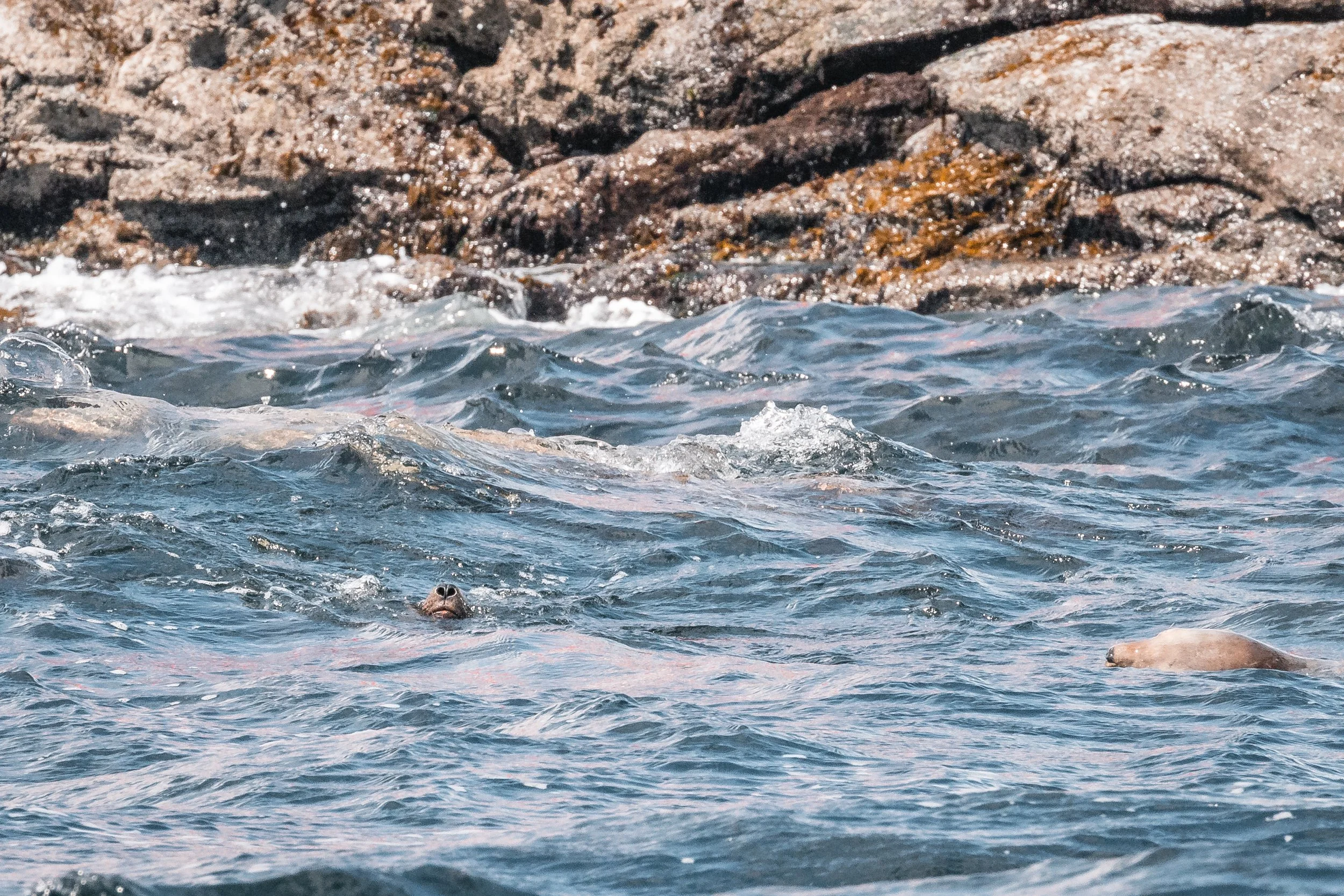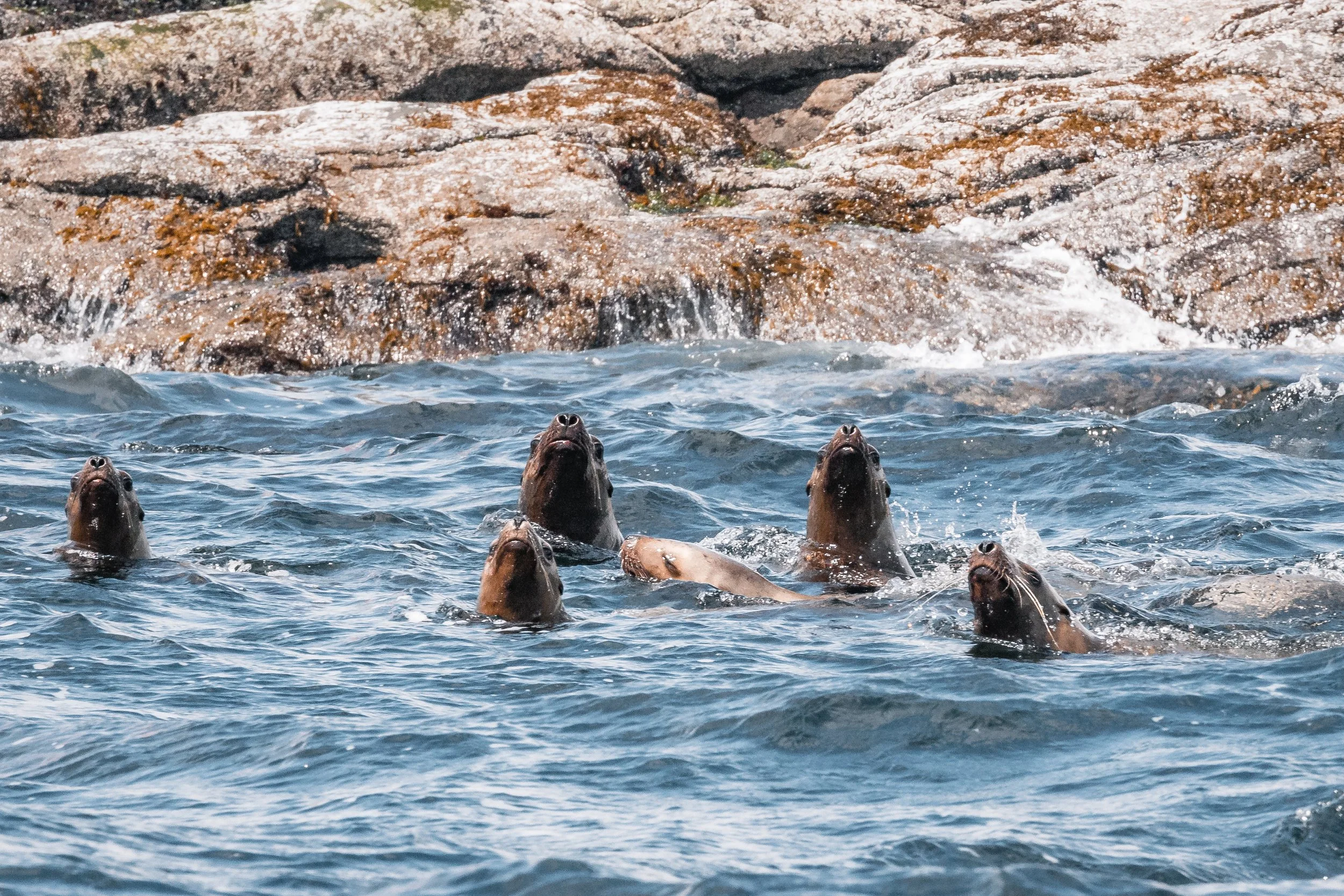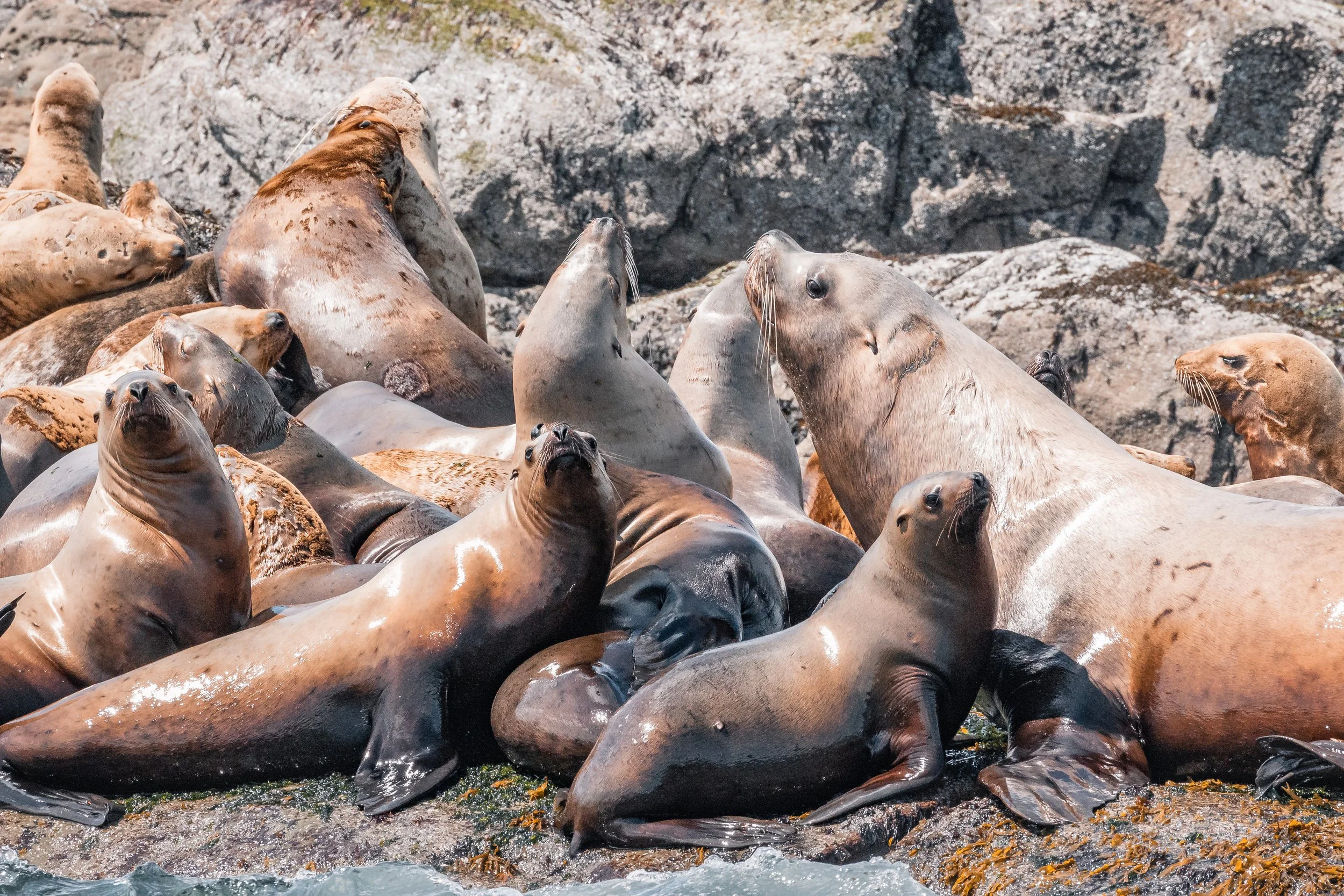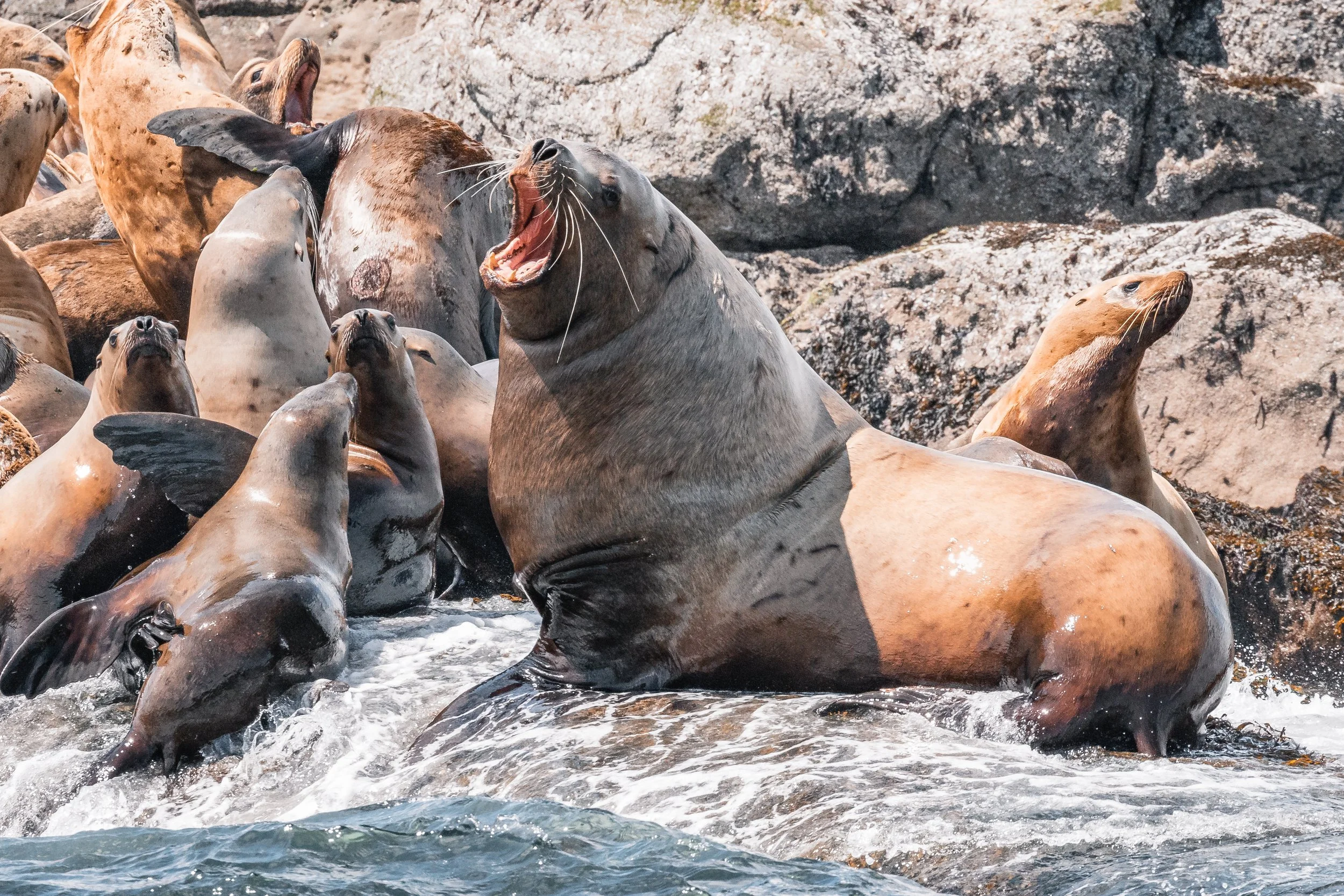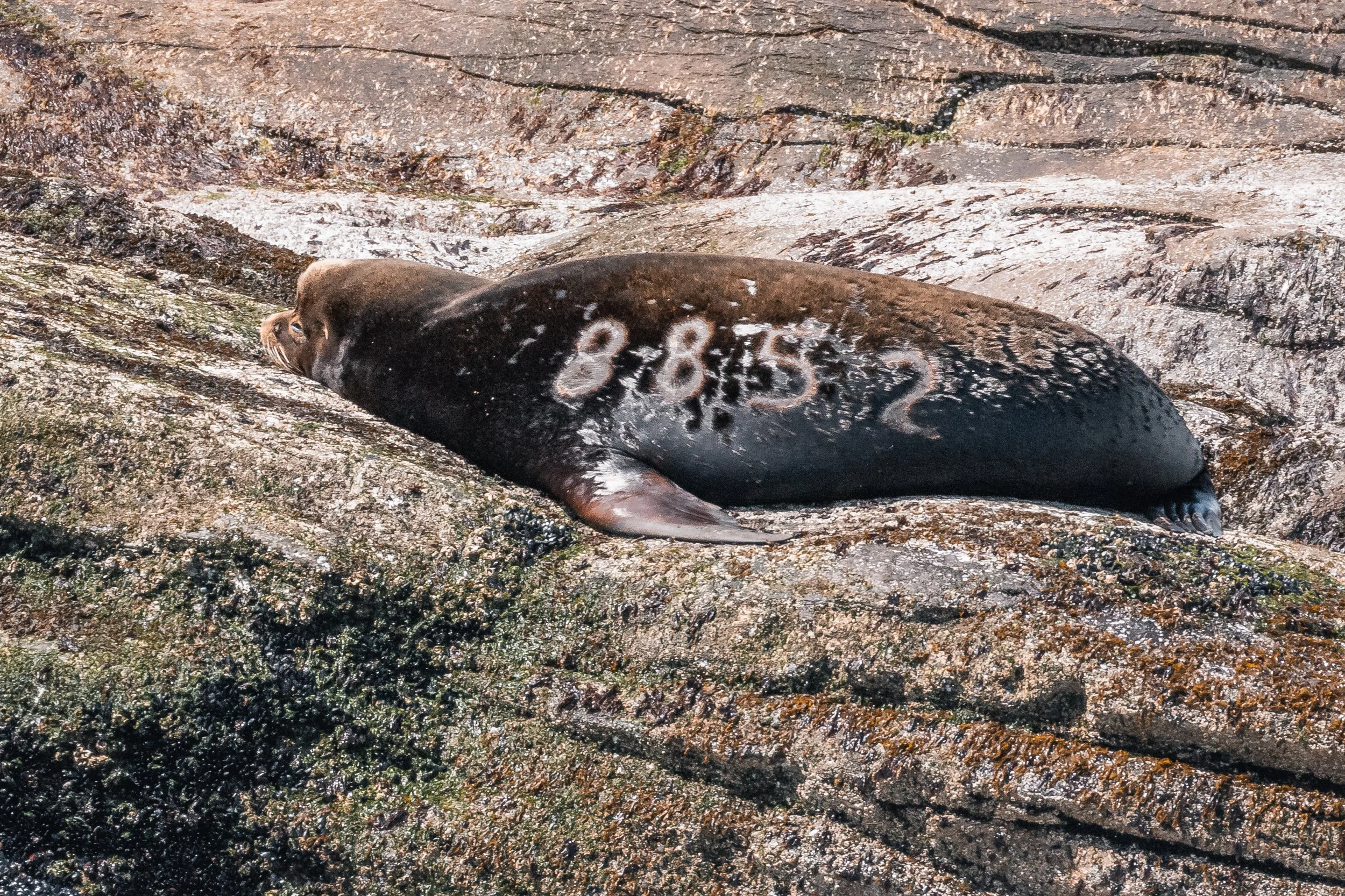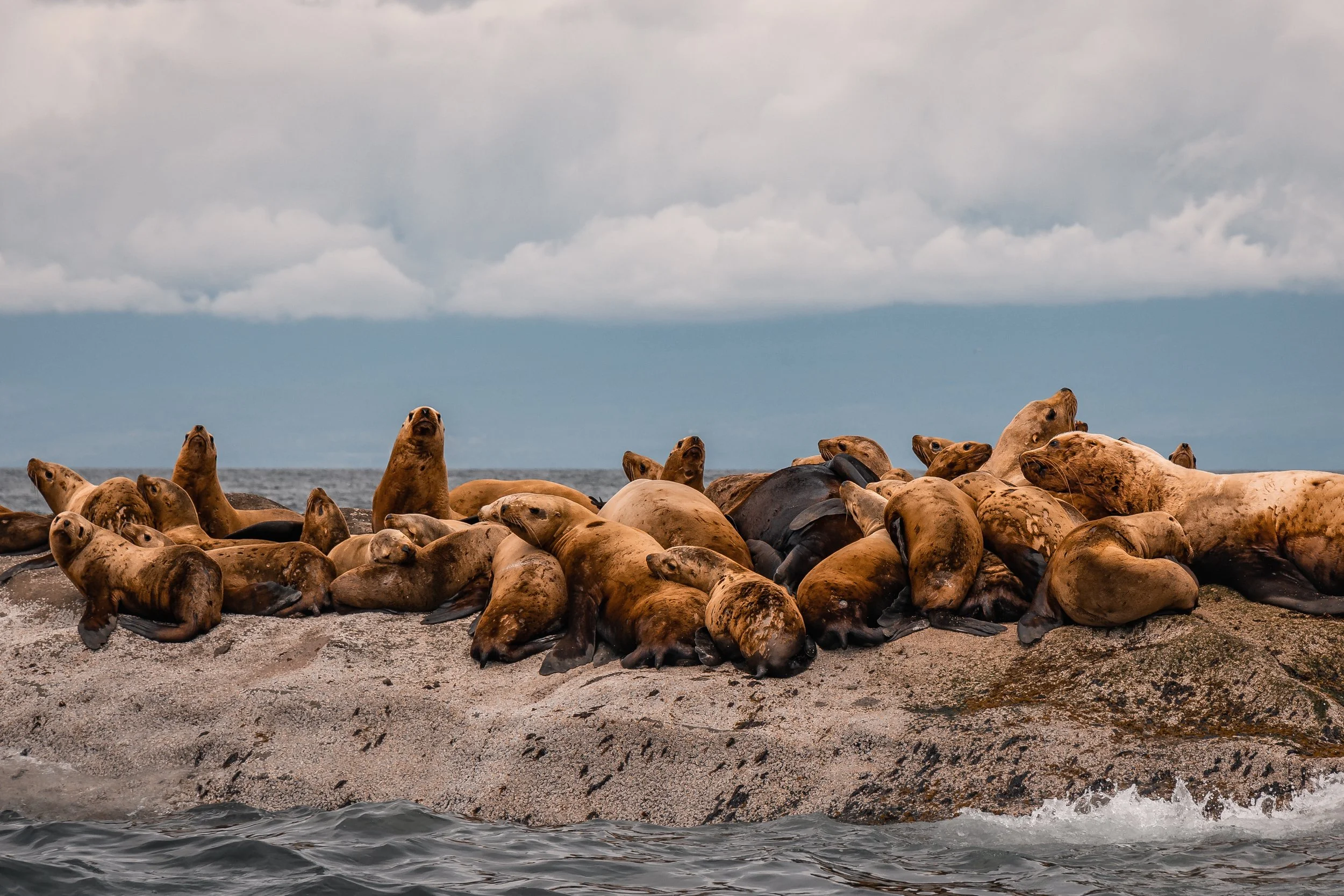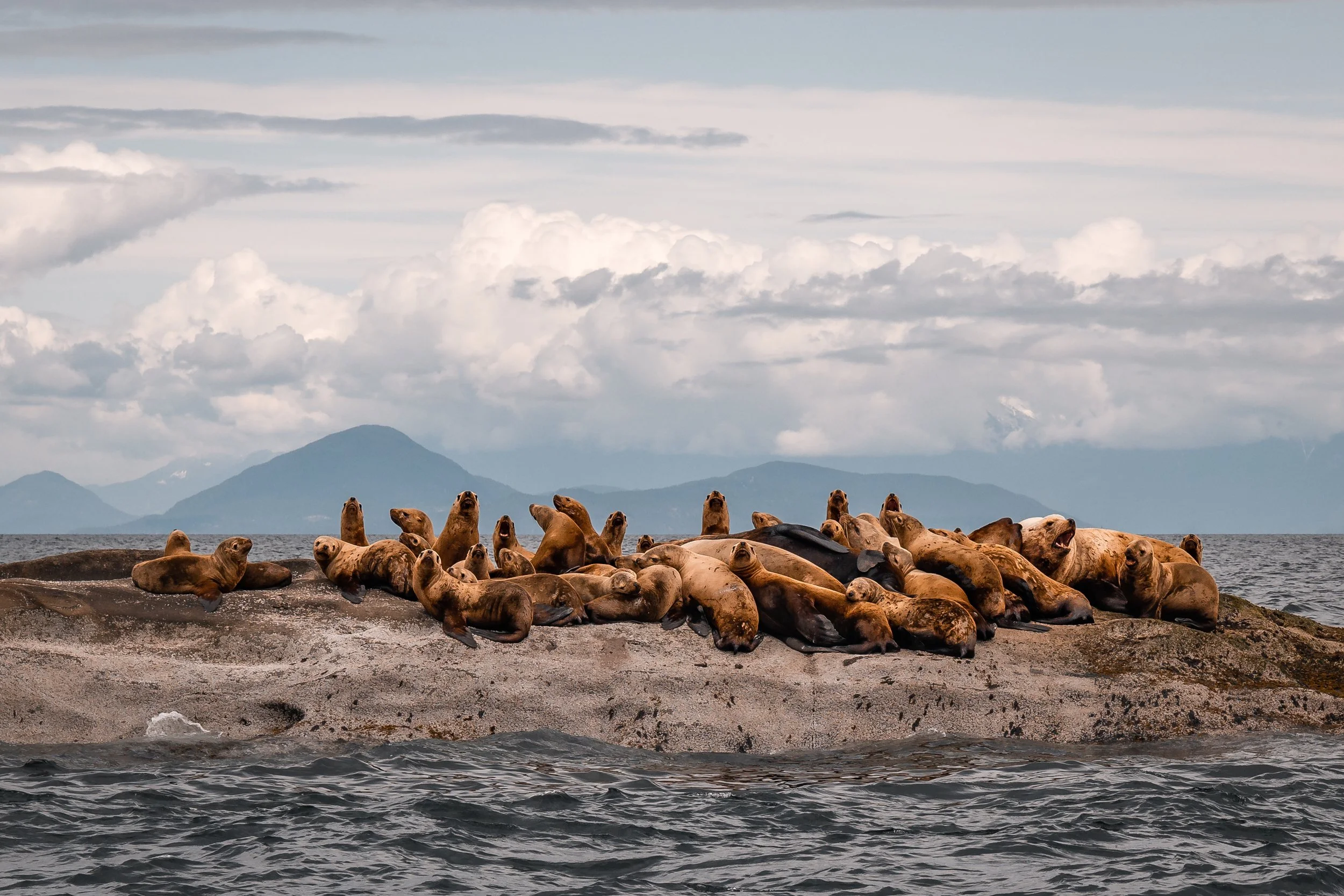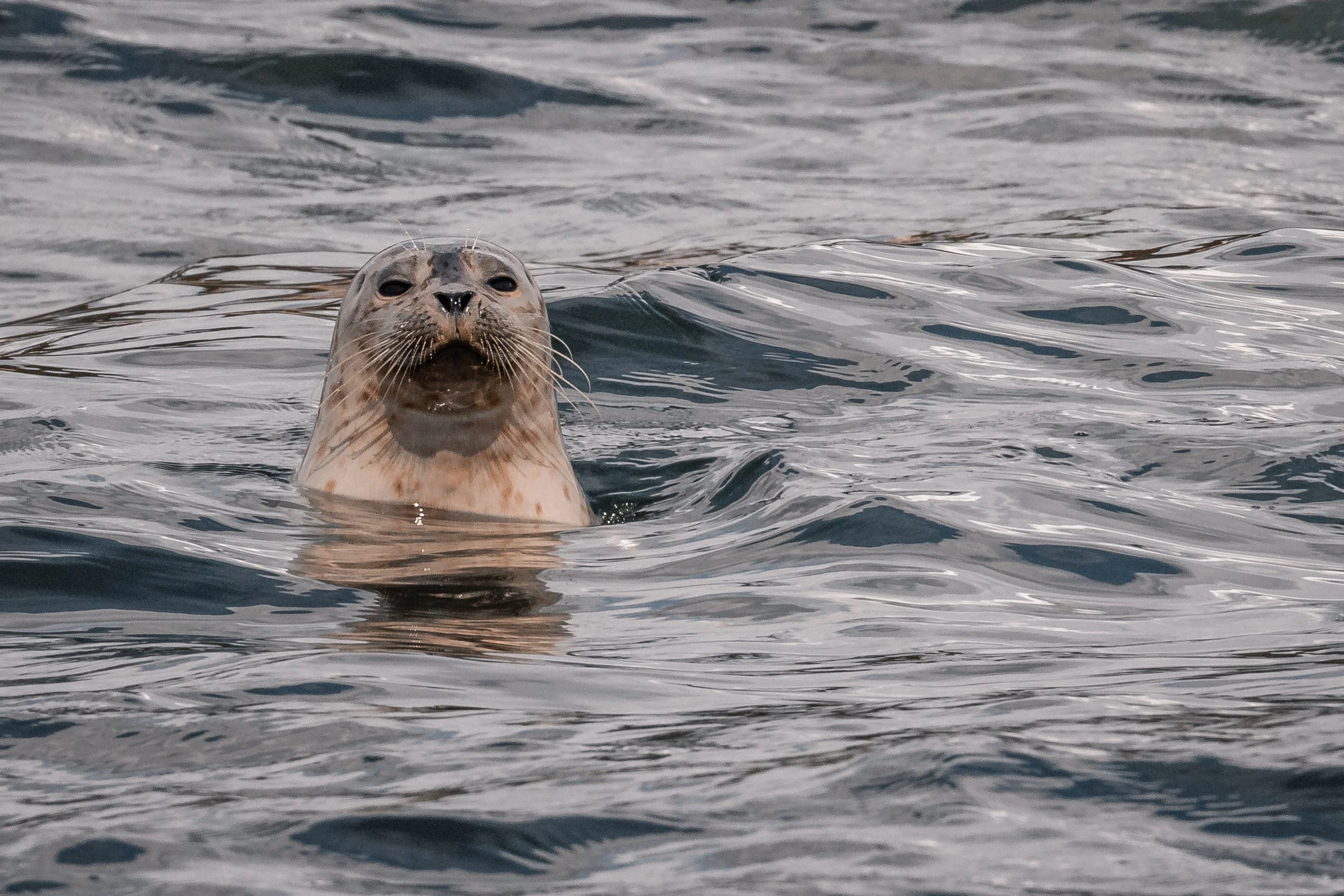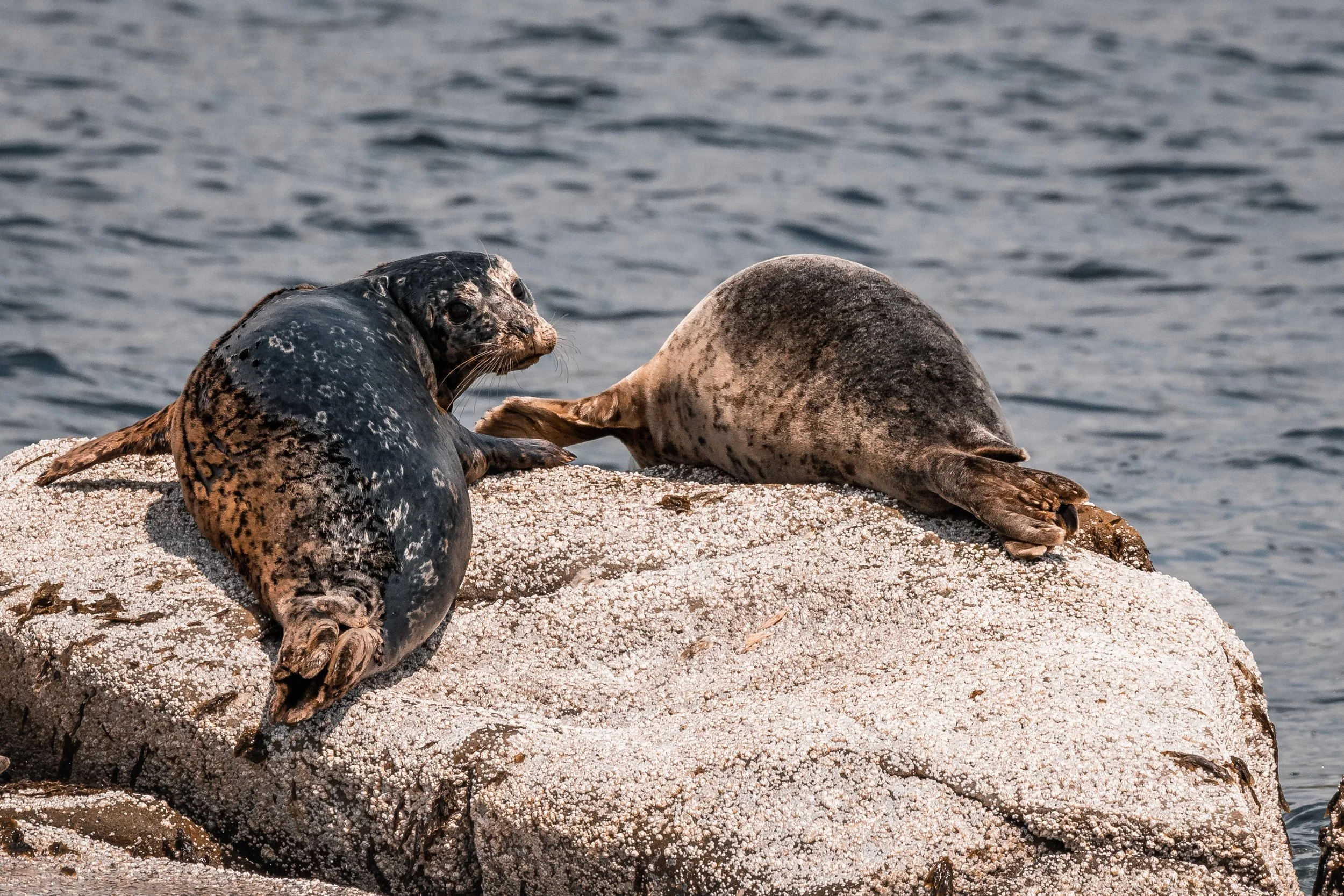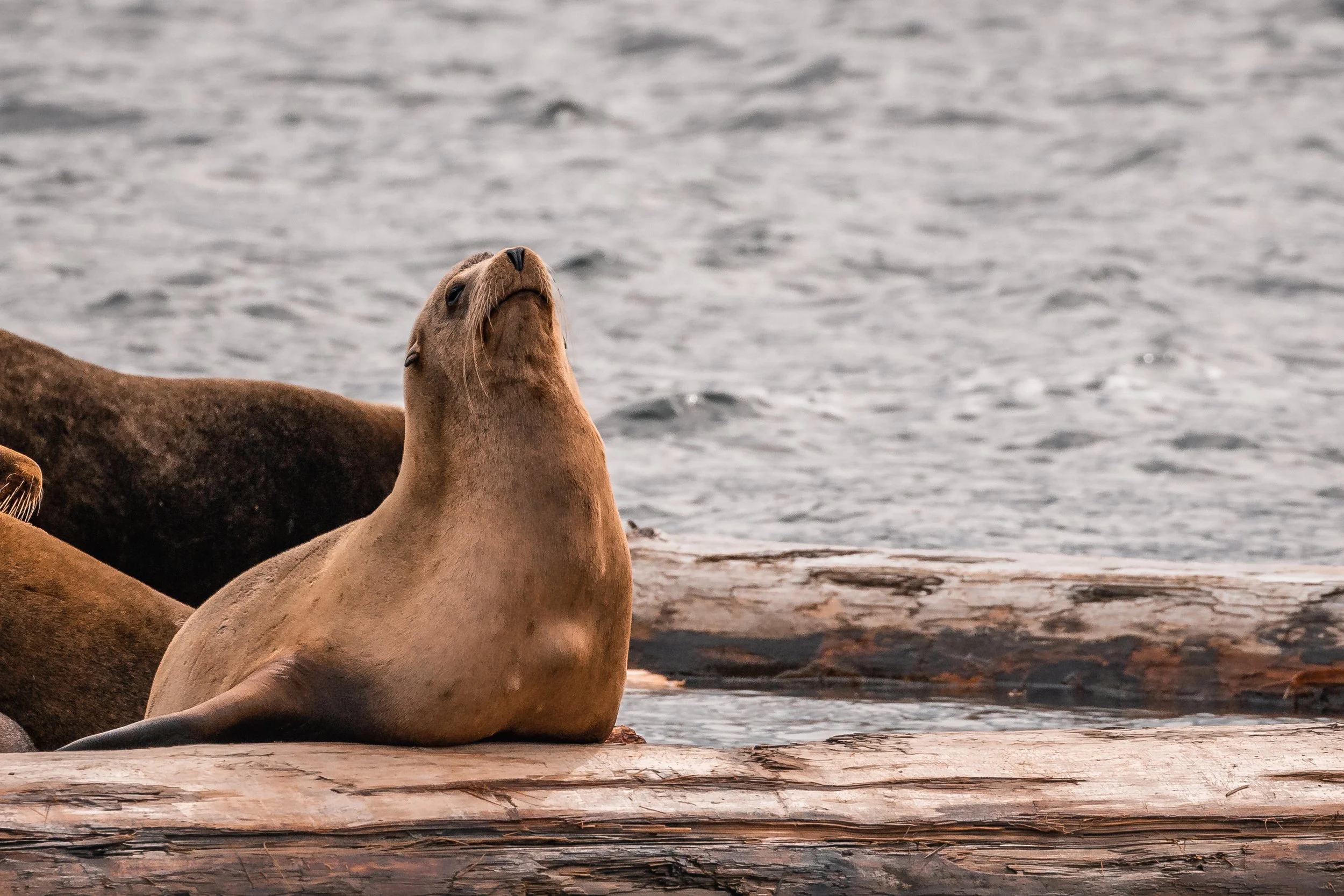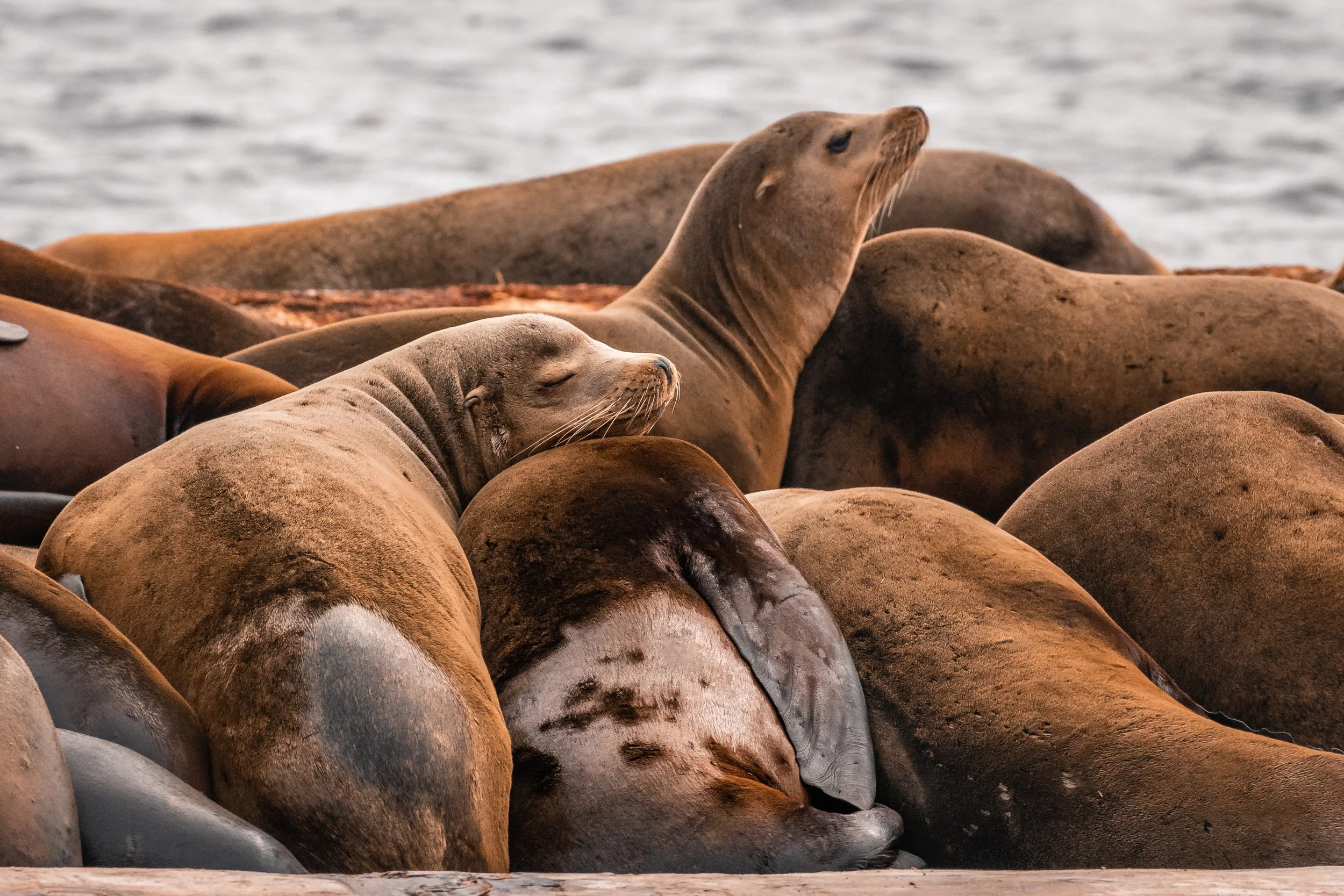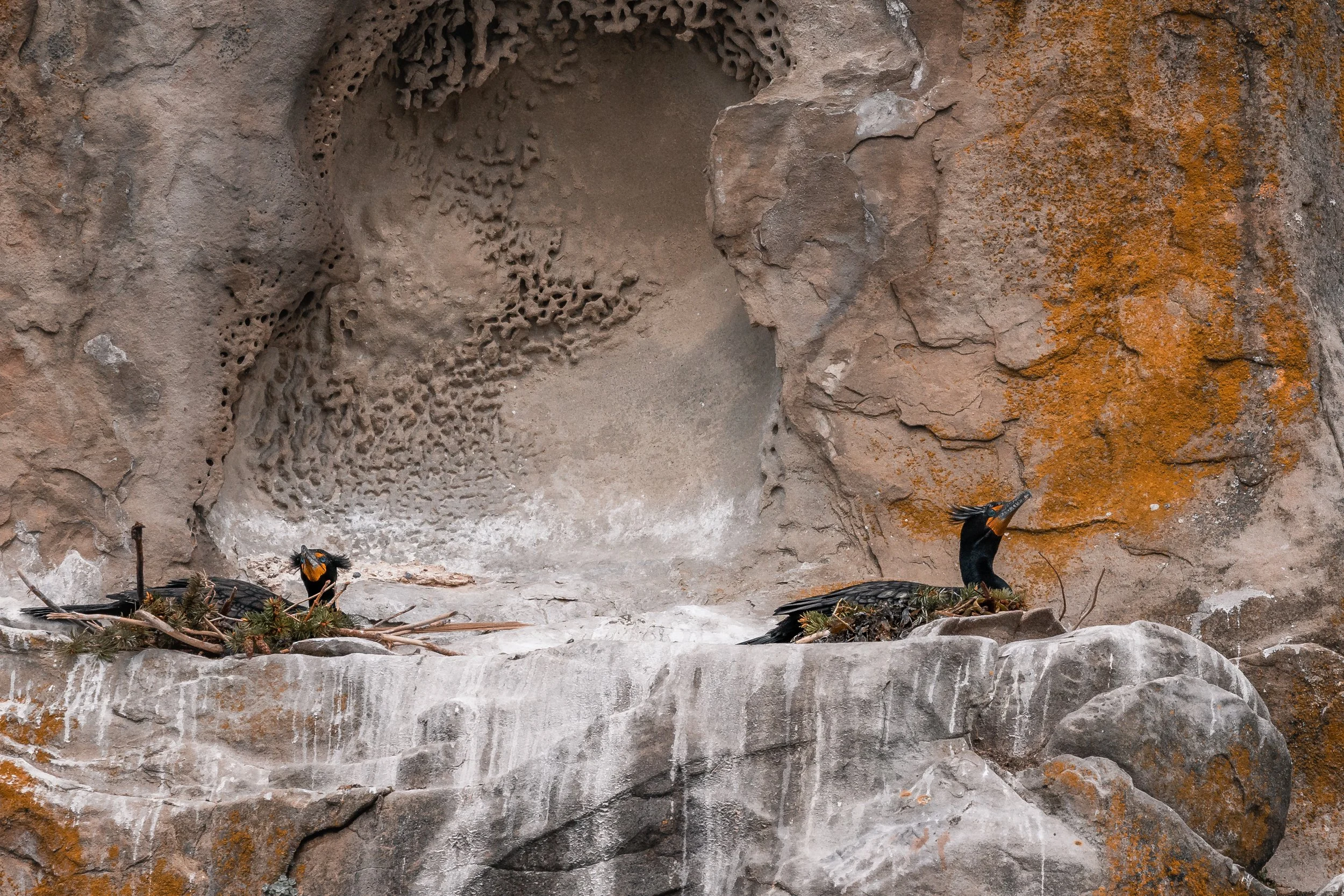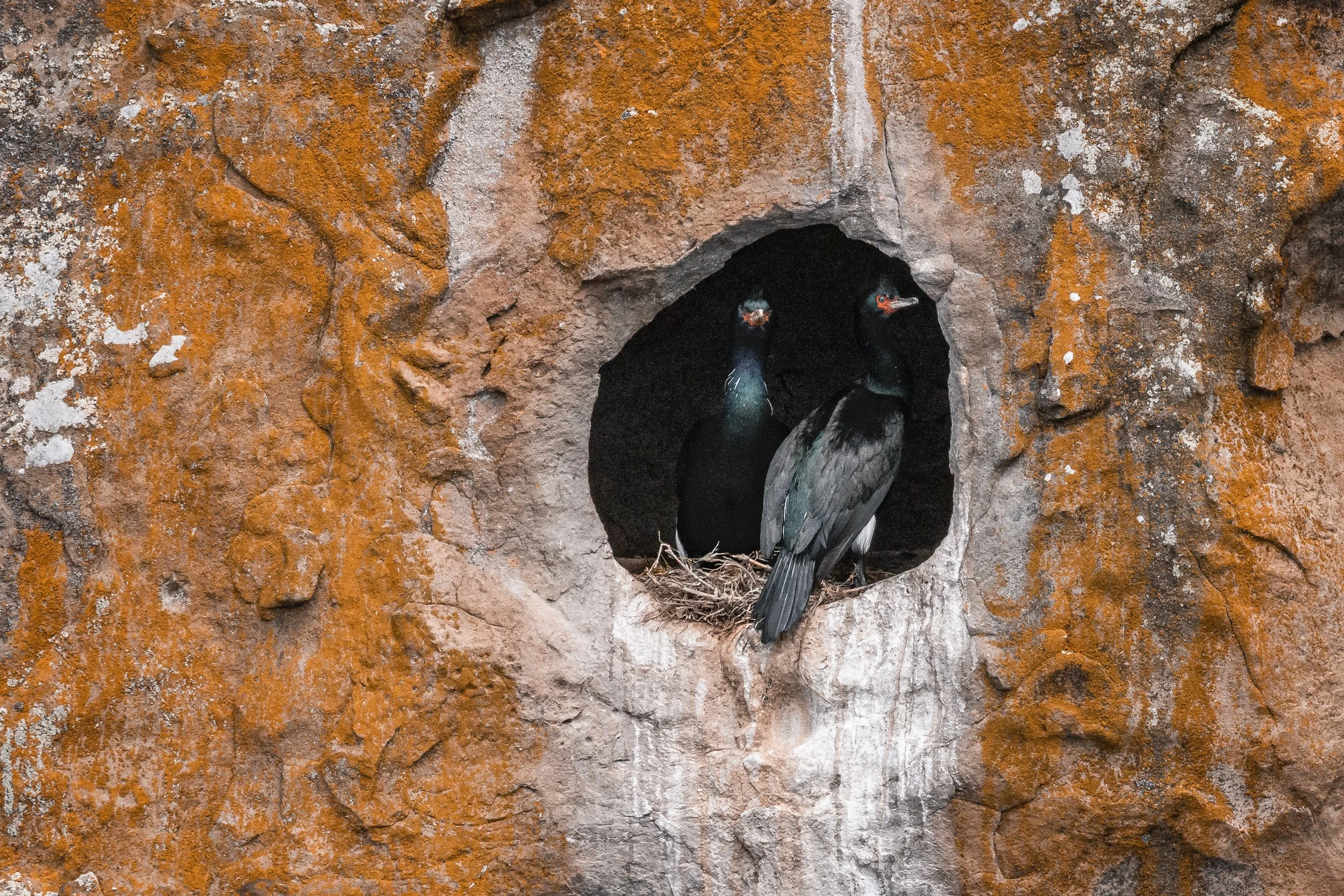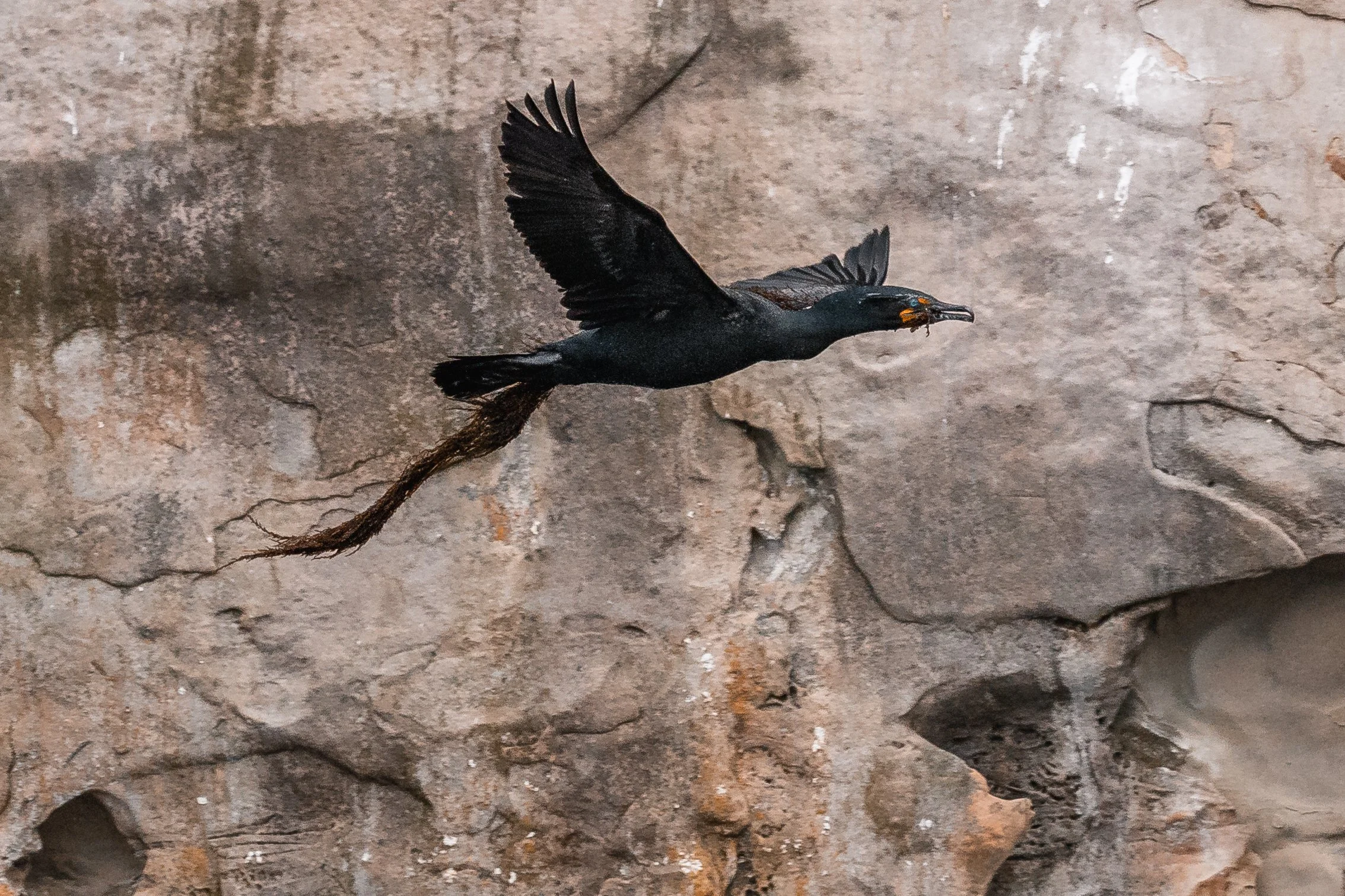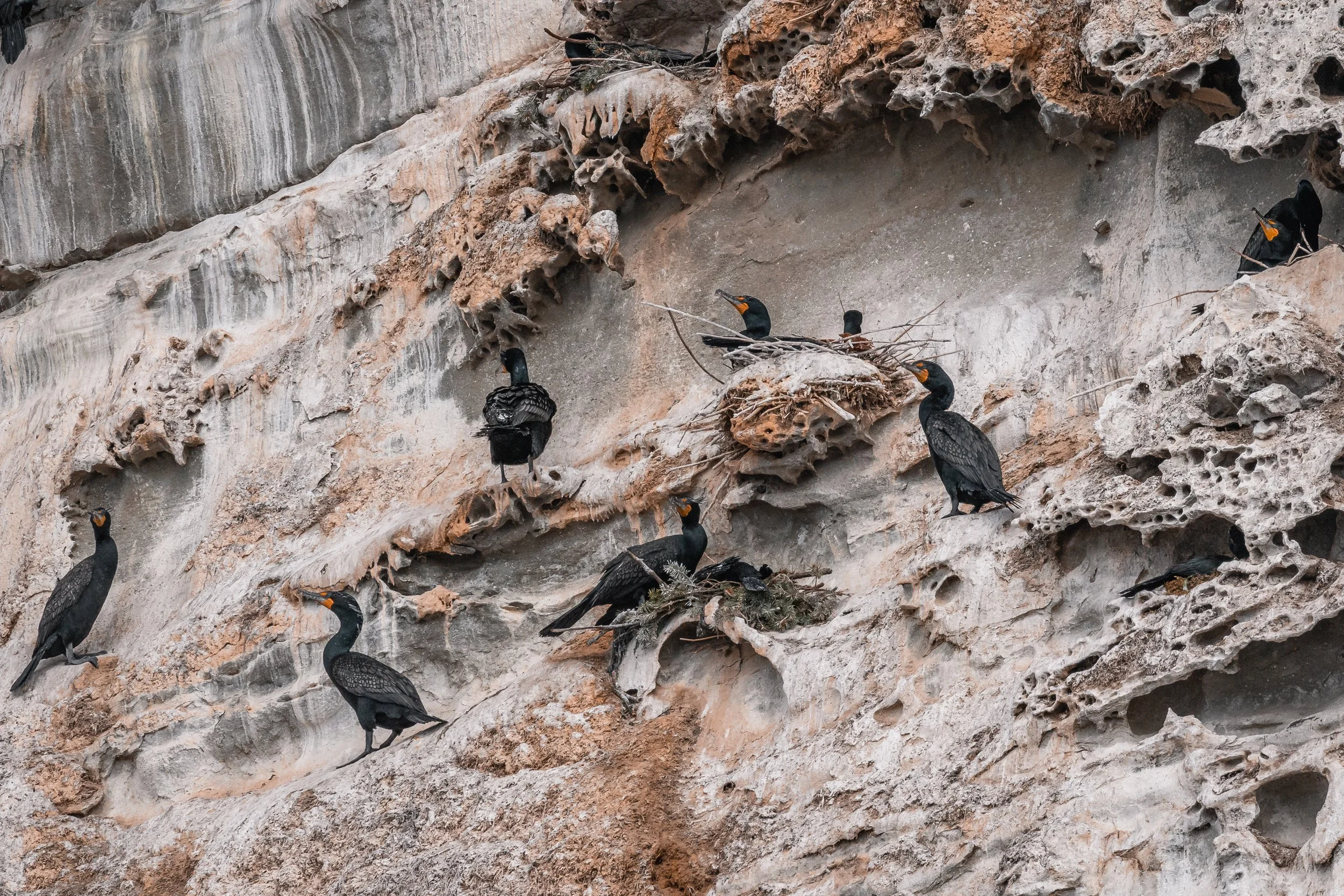May 13th - Touring the Gulf Islands
As our two boats pushed off the docks today there were a few reports of blows off Gabriola Island heading north, so our ships sailed out into the Strait to look for the whales. These were old reports, and finding whales after several hours can be very hard. Whales can move quickly, change direction with no warning, or even stay in the exact same place.
As we rounded Protection Island all eyes scanned the water for the reported whales, but no luck. Our semi-covered vessel stopped by at Entrance Island to take a look at the Steller sea lions on the rocks. These guys were loud and active today, barking at each other as we slowly drifted by. At one point a whole bunch jumped in the water, startling many of the others nearby. They started swimming around, several heading off to go swimming, likely looking for a bite to eat, while the others watched from the water, eventually making their way back to the cuddle puddle.
Little snoot. Photo by Beka Pirker
Lunch time! Photo by Beka Pirker
Photo by Beka Pirker
Photo by Beka Pirker
Why the numbers? Population tracking is a hard task to do because it’s impossible to count every individual animal in a population. Instead of trying to count each individual, especially when everyone tends to look the same, biologists will add markers, or numbers like this, to the animal and then release them into the wild. Whenever they do the population survey again, they will count how many animals returned to an area with the marker. Using some fancy formulas, which can even be species-specific, biologists can more accurately determine how many animals are in the total population.
Photo by Beka Pirker
This kind of tracking may seem pointless, especially in populations that appear stable or healthy, but when you look at the history of marine mammals in our waters, knowing a population’s size is very important. Pinnipeds (fin-footed mammals) often get blamed for fish stock declines and many people view these animals as pests, even claiming they are “overpopulated”. In the 1970’s a pinniped cull was done, and sadly most of our pinnipeds were hunted in the Salish Sea, reducing numbers drastically and putting all our pinnipeds on the Threatened or Endangered Species lists. People got used to seeing our pinnipeds in low numbers and began to believe that those low numbers were normal numbers. Because our pinnipeds now have healthy populations, a lot of people are under the impression that they are “overpopulated” and have begun requesting another pinniped cull. Mother nature has her own ways of controlling population numbers just fine. If populations get too high, they will run out of food, or disease will spread through overcrowded areas resulting in a natural decline. Humans do not need to intervene or control the populations of wild animals, it’s best we leave them to do it themselves. Often when we get involved and try to control things, based on what we “think” they should be, we cause more damage than we mean to. In our marine ecosystems, food webs are very tightly intertwined, and every species relies on every other species. Removing or even reducing one species’ population could cause decades-long problems we aren’t prepared to deal with that can be even worse than the “problem” we were trying to fix in the first place.
Photo by Janine Van der Lindin
At this point, our boats decided to split up and cover more ground. Our Open vessel Keta travelled around the east side of Gabriola Island towards the Flat Top Islands where they stopped to see Pacific harbour seals on Saturnina island. Saturnina is a frequent stop for us, as it is a popular site for our harbour seals to hang out. Often while we are stopped here we get to watch Turkey Vultures circling above, Bald eagles perched in trees or Great blue herons stalking the shallows for a bite to eat. Saturnina went up for sale a few years ago and we wondered if it would be purchased for development, which would mean we would lose one of our beautiful wildlife spots. Thankfully last year the island was purchased by the BC parks department and is being converted to a wildlife reserve. This means we will get to continue watching our seals, eagles, vultures and herons on the island for years to come without fear of the island being developed.
They (the Open vessel) then made a quick leap over to the “stinky rocks” near the Valdez Island shoreline. There were Steller sea lions and California sea lions lounging about there. It won’t be long before our sea lions begin to disappear again. Every year our Steller sea lions will head to the North end of the island, while our California sea lions will head south for the breeding season. They will remain there for roughly 3 months before returning to our waters where they spend the winter.
Photo by Janine Van der Lindin
Photo by Janine Van der Lindin
Photo by Janine Van der Lindin
After leaving the sea lions Keta traveled south through the Strait of Georgia, scanning the open waters for any blows. The waters were a bit choppy today, but even so, there were no blows. They came into the Gulf Islands through Active Pass and headed up through the inner channels, winding their way back towards Nanaimo.
Photo by Beka Pirker
Meanwhile, our other vessel had left Entrance Island and travelled through Dodd Narrows. Heading south, they stopped briefly at a small rock just outside the Thetis Island marina to see Pacific harbour seals basking in a bit of sunlight. These curious rock sausages watched us as we watched them.
Peekaboo with the Pacific harbour seals. Photo by Beka Pirker
“I’m watching you…always watching… always” Photo by Beka Pirker
As we watched our seals the Thetis Island ferry made a passing, and we took that opportunity to fall in behind the ferry and follow it out of the harbour. We continued south through the islands heading for Sansum Narrows. This channel winds between Saltspring Island and Vancouver Island, with steep cliffs on either side, covered in trees all bright green with fresh spring growth leading to some breathtaking views.
We rounded the south end of Saltspring Island, watching with crossed fingers for a blow on the horizon, as very early in the morning (hours before leaving the harbour) a whale had been reported in the area. After scanning the surface it looked like that morning whale had other plans and hadn’t stuck around for us. Our vessel turned north words, travelling up the east side of Salt Spring Island now.
Photo by Beka Pirker
Photo by Beka Pirker
Both vessels went back through Dodd Narrows, heading for the Nanaimo harbour, but not before stopping a few more times for wildlife. We stopped at the Harmac pulp mill to see the haul out of California sea lions. Every year when the California sea lions return to the Salish Sea the log booms outside Harmac become the hot spot. These sea lions spend all winter lounging on the logs, paying no mind to the tug boats that drive circles around them on a daily basis, often shooing them off the logs to move the booms around. What draws these sea lions to such a loud and busy waterway? We believe that Dodd Narrows may have something to do with it. Dodd Narrows is seconds away and teeming with life, providing the sea lions with a near-constant supply of food. Imagine having your fridge right outside your bedroom door - it’s kind of like that! These sea lions deal with the loud tug boats, having their beds moved and temporarily removed, and all the other goings-on in the area, all for the easy access to fish.
Photo by Beka Pirker
Photo by Beka Pirker
Photo by Beka Pirker
Photo by Beka Pirker
The final stop on the tour was the Gabriola Bluffs. These sheer cliff faces extend well below the water's surface and provide secure nesting sites to our local populations of Double-crested cormorants and Pelagic cormorants. These long-necked marine birds make their nests on the cliff edges and holes which have been eroded away by the years of sea spray and high winds. These migratory birds return to the same nests, expanding and fixing them up year after year, laying their eggs and raising their chicks, all just minutes out of the Nanaimo harbour. It won’t be long before we start to see the naked little babies poking their heads out of the nests, demanding more food from mom and dad.
Photo by Beka Pirker
Photo by Beka Pirker
Photo by Beka Pirker
Photo by Beka Pirker
A Salish Sea adventure waits for you!
We have daily public tours departing from downtown Nanaimo at 10:30AM and 3:30PM. These tours are 3-5 hours long, depending on how far we must travel for the whales, but average around 4 hours.
Planning a special event and need a fun local activity to do?
We do have private tour options! Call or visit our office to learn more about them.
We have 2 styles of boat to choose from, depending on the experience you want.
Our semi-covered vessel offers comfortable seating in a heated cabin with windows to look out of, as well as a large viewing deck to stand on when we are stopped with wildlife.
Our open zodiac style boats offer near 360-degree views, constant fresh air, and the privilege of wearing a fancy anti-exposure suit. Not only the pinnacle of high fashion but also your personal flotation device!
Yes! We do have a bathroom on all our boats. Even the open ones.
To book your own adventure, give us a call between 8:00AM to8:00PM at 250-667-5177, visit our office staff in our harbour-front office between 9:30AM to 5:00PM at #5 - 90 Front Street Nanaimo, or book directly through our website!

